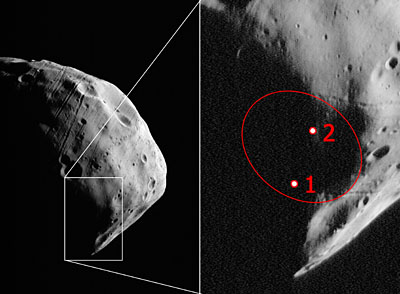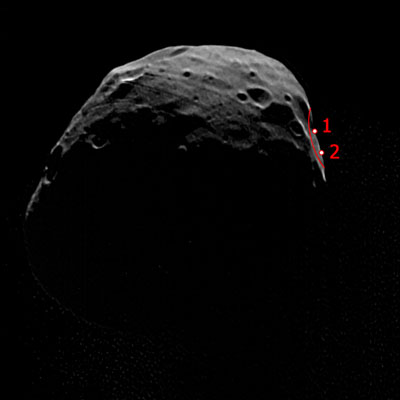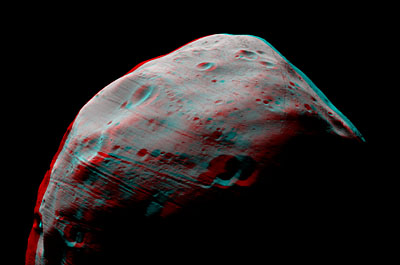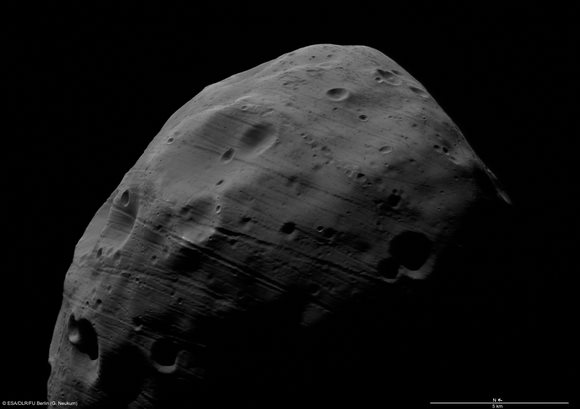[/caption]
On July 23, Europe’s Mars Express spacecraft flew only 93 kilometers from Mars’ moon Phobos, and took the most detailed images ever of the small, irregular moon. Additionally, the spacecraft made other close flybys during the past few weeks, and creating a variety of images. The moon’s grooved surface can be seen in the pictures quite clearly, but the origin of the grooves is not known. They could have been formed by ejecta thrown up from impacts on Mars, or if they could be caused by internal fissures result from the surface regolith, or soil, slipping into internal fissures. Whatever the cause, enjoy these new hi-resolution images of Phobos.

The best images taken by Mars Express have a resolution of 3.7 m/pixel and are taken in five channels different channels to create 3-D images, and to analyze the physical properties of the surface. Measuring 27 km × 22 km × 19 km, Phobos is one of the least reflective objects in the Solar System, thought to be a capture-asteroid or a remnant of the material that formed the planets.
A Russian sample return mission called Phobos-Grunt (Phobos soil), is scheduled to launch in 2009. It is expected to land on the far-side of Phobos at a region between 5° south to 5° north, and 230° west to 235° west. This region was last imaged in the 1970s by the Viking orbiters. The inset here shows potential landing sites for the Russian mission.

The images obtained by several other spacecraft so far have either been of a lower resolution, or not available in 3D and have not covered the entire disc of Phobos. This is also the first time that portions of the far-side of the moon have been imaged in such high resolution (Phobos always faces Mars on the same side). Mars Express’ High Resolution Camera (HRSC) Super-resolution channel (SRC) image taken on 22 July 2008 from a distance of 4500 km, showing the illuminated edge of the potential landing site of the Russian Phobos-Grunt mission.

The imaging team is still working on producing additional images of the moon, including more in 3-D like this one. Managing the close fly-bys was an operational challenge, made possible by spacecraft operations engineers and scientists who worked together to specially optimise Mars Express’s trajectory and obtain the best possible views.
Original News Source: ESA


Convert this Phobos old fashioned red-blue 3 D piece into regular photos or stereoscopic pictures, and learn how to do it with all NASA poor quality 3D picture.
Fascinating article Nancy, many thanks.
So many questions… Could Phobos be a part of the asteroid that hit Mars and did so much damage to the point of demagnetising the planet?
Those striations on the side – did Phobos ever rotate? It looks like a laser beam was fired at Phobos as it rotated.
Not all the striations are parallel, It doesn’t look geological to me, it looks more like debris from the Kupier belt than a naturally formed moon.
Anyone have any ideas?
I want to go and buy some 3D goggles now.
I also think it probably rotated but possibly not around Mars. I also think it was captured…. I think, as a lot of others do, is that the reason why Mars has no magnetic field is because the core (iron) was small and also unable to sustain nuclear fission and cooled. The core “died”…
The terrain on this moon is simply fascinating!
We need to get there as soon as possible… I better not be cursing our species on my death bed because we had yet to get there in my lifetime.. 🙁
If the Russians can pull this off successfully, I will be the first one to holler “Molodyets!!”
Great 3-D image. Wot! ! No conspiracy theories yet?
Paul.
@Al Hall
I agree that there is no magnetic field in Mars because there is no liquid Iron core to generate it. But the core did not cool because of the lack of nuclear fission since nuclear fission is not the reason for any core heating. The core heating process are 1. Inherent or Primordial heat leftover from the formation period.2.Frictional Heating due to the settling of heavy materials.3. Radioactive decay of material…
Clearly the marks are rocket burns from when the Martians took off from Mars and its moons to flee the planet when it became uninhabitable and migrate to Earth… 😉
The grooves are a definite mystery. I’ve never seen any possible explanation – not yet anyway. I cannot even dream one up myself – a very unusual circumstance. Faults come to mind, but they are weird ones if that’s what they are.
They seem to have formed after the large imact craters, as the lines dip down into the crater floors. Maybe they were formed from dust rings around Mars millions or billions of years ago. If Phobos wobbles in it’s orbit (or used to), then that could explain why some are not parallel.
They also look like trails left from rocks that roll in mud or sand, but the lines wouldn’t be so strait if that were the case.
Interesting!
Here is a wacky one!! Maybe Mars two moons used to be one. The martians were mining for resources and the moon split in two. This causing a chain reaction that destroyed Mars! This could be a script for a movie.
Since common theory points to an object striking Mars at one time, it is likely this is a large piece of what was left over. Either from Mars or it’s kisser.
I thought about a laser making the marks as well!! As if some ET flew by and thought, “Hey, lets mess with the Earthlings. They are just intelligent enough to go crazy about lines”.
Since most (if not all) the lines appear to be younger than the craters; it makes it really tough to figure out. I can’t get figures to work out, as far as a small passing meteor glancing along the side and following the contour with just enough gravity to hold it.
I think someone mentioned how the lines were too straight; remember the speeds they would be travelling at… if near opposite direction, most likely the lines would always be straight. So the rolling err maybe skidding rock isn’t a bad one to go with.
But my numbers fail in how constant one line is passing over two craters; it would have to be one heavy rock hitting just the right angle. So I really don’t like this theory, and the way they go through craters eats at me for some reason.
Wouldn’t mind seeing everything in color as well. Another odd way to look at it, is to think of a cross section of the earth around the Grand Canyon area. The way some layers transition, it could be possible the area between the layers is a bit looser or unstable and fell off.
Lastly, perhaps they are cooling lines from an area of a small planet which was once molten.
Since the lines hold up even through craters, I tend to lean towards the last two.
However, in the end, your guess is as good as any of mine.
Well I guess MRO has ruled out the dust cloud theory around Phobos! At least to within 93 km…
I’m with the rolling rock idea. Phobos barely fills its Roche Lobe, so its pretty easy for surface material to get kicked up and start running around on the surface. Hell! Those crazy Russians were sending a “hopper” to jump around on the surface since there’s hardly any local gravity! Genius!
I just hope the Phobos-Grunt mission has better luck than its predecessors. Pretty ballsy trying to do a sample-return though!!
A few images of Phobos…..
http://marsesa.9f.com/slide_shows/Phobos/Phobos6.gif
http://marsesa.9f.com/slide_shows/Phobos/Phobos22.jpg
http://marsesa.9f.com/slide_shows/Phobos_Full_Scale/Phobos27.jpg
I wonder: how are these lines positioned in relation to Mars?
Could tidal forces have anything to do with it?
Also, it looks almost as if the lines were eroded into the soil. I don’t know how this could happen, though.
Whatever the cause, it’s sure to be amazing.
Since Pluto has been downgraded from a planet, due to its size, is it possible to downgrade a moon (actually, “satellite”) because it’s too small to qualify? If so, what would it be called? A moonette? Pseudosatellite? Orbiting rock?